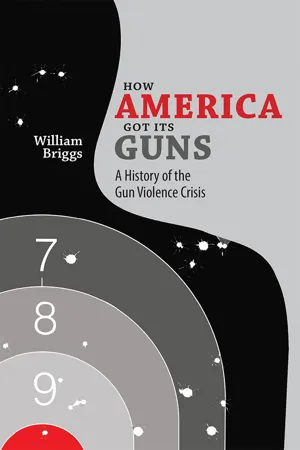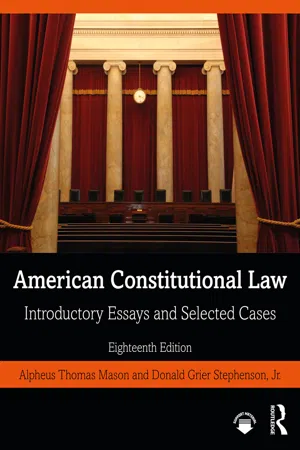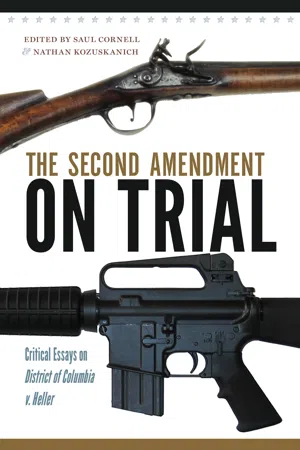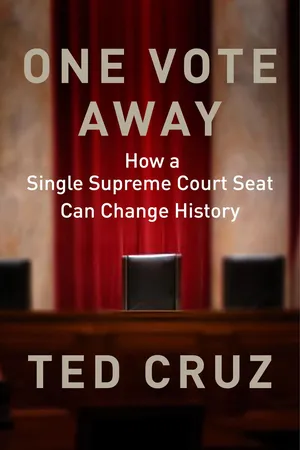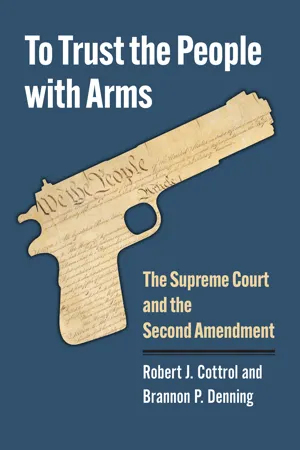Politics & International Relations
McDonald v Chicago
"McDonald v. Chicago" was a landmark Supreme Court case in 2010 that addressed the issue of gun control. The Court ruled that the Second Amendment's right to bear arms applies to state and local governments, not just the federal government. This decision had significant implications for gun laws and individual rights across the United States.
Written by Perlego with AI-assistance
Related key terms
6 Key excerpts on "McDonald v Chicago"
- eBook - ePub
How America Got Its Guns
A History of the Gun Violence Crisis
- William Briggs(Author)
- 2017(Publication Date)
- University of New Mexico Press(Publisher)
26 The opinions on both sides used more ink arguing about legal theories than spelling out specific guidelines on admissible restrictions on gun use. Ironically, the decision did not settle the fate of the Chicago gun ban. The case was returned to the Seventh Circuit, where federal judges decided—with little guidance from the Supreme Court—how Chicago would need to modify its gun laws. In June 2014, Chicago’s handgun ban was ruled unconstitutional. The Chicago City Council replaced it with an ordinance placing strict controls on sales of handguns. The ordinance allows sales only in certain parts of the city and outlaws sales at gun shows.Many Court analysts forecasted the impact of the McDonald decision on the lower courts: “The dueling of lobbyists will now be replicated by dueling attorneys.”27 “The real action will be in the lower courts, to which fall the grubby tasks of applying the constitutional principles the Supreme Court pronounces.”28 “The Court has put the federal judiciary to the never-ending task of quasi-legislating a gun code.”29 The decision “increases the number of possible constitutional claims, and it also increases the opportunities for litigation.”30 And the decision “is destined to be a virtual full employment act for gun rights lawyers.”31For gun rights advocates, the decision was exalting. The NRA’s Wayne LaPierre praised it as “a great moment in American history … a vindication for the great majority of American citizens who have always believed the Second Amendment was an individual right and freedom worth defending.” He continued on a realistic note:We are practical guys…. The NRA will work to ensure this constitutional victory is not transformed into a practical defeat by activist judges…. The NRA will not rest until every law-abiding American citizen is able to exercise the individual right to buy and own a firearm for self-defense or any other lawful purpose.32 - eBook - ePub
American Constitutional Law
Introductory Essays and Selected Cases
- Donald Grier Stephenson Jr., Alpheus Thomas Mason(Authors)
- 2021(Publication Date)
- Routledge(Publisher)
In dispute was the validity of an ordinance in the District of Columbia that effectively banned the possession of handguns and required that rifles in the home be disassembled or disabled by trigger locks. Speaking for five justices in striking down the ordinance, Justice Scalia explained that “on the basis of both text and history … the Second Amendment conferred an individual right to keep and bear arms.” Heller is highly significant because it declared for the first time the existence of a personal constitutional right of firearm possession, particularly in the context of self-defense. In so doing, however, Heller has hardly ended the firearms debate. In acknowledging that the Second Amendment right is not “unlimited,” the Court left open the possibility of constitutionally acceptable firearm regulation, as opposed to outright prohibition. Validity would thus presumably turn on reasonableness, although the contours of such regulatory reasonableness must still be determined. Moreover, would the right recognized by Heller apply to state regulation of firearms? This question was crucial because most firearms regulation in the United States is the product not of Congress but of state and local governments. An answer was forthcoming in McDonald v. City of Chicago (2010), which for the first time applied the Second Amendment to the states. Given the developments in Heller and McDonald, the prospects seem strong that the Second Amendment will remain politically and legally significant. Key Terms civil liberty civil right due process of law recusal incorporation ordered liberty total incorporation double standard fair trial rule due process revolution new judicial federalism new double standard Second Amendment Antifederalists Queries Reread the statement by Justice Jackson on the Bill of Rights at the very beginning of this chapter - eBook - ePub
The Second Amendment on Trial
Critical Essays on District of Columbia v. Heller
- Saul A. Cornell, Nathan Kozuskanich, Saul A. Cornell, Nathan Kozuskanich(Authors)
- 2013(Publication Date)
- University of Massachusetts Press(Publisher)
McDonald v. City of Chicago, 130 S.Ct. 3020 (2010).78 . See Symposium, “Firearms, Inc., or, A Collection of Essays and Articles Discussing McDonald v. City of Chicago, the Second Amendment, Its Contour in Light of District of Columbia v. Heller, and Its Possible Incorporation through the Fourteenth Amendment,” Cardozo Law Review De Novo (2010): 1–202.79 . After McDonald the incorporation of the first eight amendments was accomplished with the following exceptions: the Third Amendment was not incorporated apart from a decision in the Second Circuit limited to that jurisdiction; the Fifth Amendment was incorporated except for the clause guaranteeing criminal prosecution only on a grand jury indictment; the Seventh Amendment was not incorporated; and the Eighth Amendment was incorporated with respect to the protection against “cruel and unusual punishments,” but with no specific Supreme Court ruling on the incorporation of the “excessive fines” and “excessive bail” protections.80 . Tina Mehr and Adam Winkler, “The Standardless Second Amendment,” American Constitution Society Issue Brief, available at www.acslaw.org/sites/default/files/Mehr_and_Winkler_Standardless_Second_Amendment.pdf .81. The notable exception is Moore v. Madigan; - eBook - ePub
One Vote Away
How a Single Supreme Court Seat Can Change History
- Ted Cruz(Author)
- 2020(Publication Date)
- Regnery(Publisher)
The Court upheld the individual right to keep and bear arms in the Second Amendment and struck down the District of Columbia’s total ban on possessing a functional firearm at home. Under the D.C. law, if a single mom kept a disassembled shotgun in her closet and a criminal broke into her apartment to attack her family, she would herself become a criminal if she assembled the shotgun in order to ward him off. In other words, the law took away the fundamental right to protect yourself in the District of Columbia. Justice Scalia, writing for the Court’s majority, emphatically rejected the constitutionality of that total prohibition. The Court established an individual right to keep and bear arms for those civilian weapons “in common use” at the time. By any measure, handguns met that test, so D.C.’s total ban on handguns was unconstitutional.The District of Columbia had criminalized the exercise of this cherished and indispensable right to self-defense. The Supreme Court rightly rejected D.C.’s blanket prohibition. Justice Scalia, writing for the Court’s majority, largely adopted the test that Texas and the other amici states had urged—a more rigorous standard of scrutiny than the lenient standard that the Bush Department of Justice had put forward in its own brief.Two years later, in McDonald v. City of Chicago, the Court finished the journey that we had urged it to begin in Heller. In McDonald, the Court rightly concluded that the individual right to keep and bear arms is a fundamental right that is, in turn, incorporated against the states. After McDonald, it is not just the District of Columbia, but also all the fifty states and every local government that is prohibited from infringing upon our fundamental individual right to keep and bear arms.Both Heller and McDonald were decided at the Court by single-vote majorities. In both cases, four justices dissented and argued that there was not any enforceable individual right to keep and bear arms.To be clear, they were not writing in favor of any particular legislation that was reasonable or permissible, or in favor of any particular gun control–policy proposal. Rather, they objected to the idea that the Second Amendment protects any - eBook - ePub
To Trust the People with Arms
The Supreme Court and the Second Amendment
- Robert J. Cottrol, Brannon P. Denning(Authors)
- 2024(Publication Date)
- University Press of Kansas(Publisher)
, that incorporated provisions of the Bill of Rights were to be applied to the states with the same rigor that they were applied to the federal government caused the Court to reexamine the question of unanimous juries. In2020 the Court in Ramos v. Louisiana reversed the position that it previously held in Apodaca v. Oregon and Johnson v. Louisiana permitting convictions for felonies by less than unanimous juries. After Ramosthe only provisions of the Bill of Rights that remained unincorporated were the Third Amendment’s prohibition on the quartering of troops in private homes, the Fifth Amendment’s right to a grand jury in criminal cases, and the Seventh Amendment’s right to a jury trial in civil cases.McDonald can only be said to have accelerated the processes of fulfilling the vision of Fourteenth Amendment author John Bingham, who intended to make the states respect the Bill of Rights. 93But McDonaldwas about more than the Bill of Rights in general. It was specifically about the Second Amendment. What impact would it have on the right to keep and bear arms? One scholar has noted that the Supreme Court’s decision inMcDonald would bring the constitutional provision into the ambit of “ordinary constitutional law.” After McDonald, the old debates about the meaning of the Second Amendment and whether it applied to the states and their various subdivisions were to be put aside. The Second Amendment would become the subject of routine litigation. Given that a right was recognized, what kind of regulation is permissible?94In the decade following McDonald ,the answer from the federal judiciary was that state and local governments would retain a great deal of latitude in firearms regulation. Lower federal courts have produced differing results. The Fourth and Ninth Circuits upheld restrictive licensing schemes, making it difficult for most citizens to get licenses to carry handguns outside the home for protection. - eBook - ePub
- Frank Miniter(Author)
- 2014(Publication Date)
- Regnery(Publisher)
McDonald, a Democrat and longtime hunter, had by then been a law-abiding resident of Chicago for more than fifty years. He wasn’t an activist. He was simply a person trying to live the American dream. McDonald explained, “I was feeling the poor blacks who years ago had their guns taken away from them [in the post–Civil War South] and were killed as someone wished. That was a long time ago, but I feel their spirit. That’s what I was feeling in the courtroom. . . . This lawsuit, I hope, will allow me to bring my handgun into the city legally. I only want a handgun in my house for my protection.”McDonald’s case went to the Supreme Court, and as with Heller, he won (McDonald v. Chicago, 2010). The Supreme Court opinion noted: “[The] number of Chicago homicide victims during the current year equaled the number of American soldiers killed during that same period in Afghanistan and Iraq . . . 80 percent of the Chicago victims were black. . . . If, as petitioners believe, their safety and the safety of other law-abiding members of the community would be enhanced by the possession of handguns in the home for self-defense, then the Second Amendment right protects the rights of minorities and other residents of high-crime areas whose needs are not being met by elected public officials.”The Second Amendment battle with the city of Chicago, however, didn’t end with the ruling. To sidestep the Supreme Court decision, Chicago quickly passed a new ordinance. City officials called the new law “the strictest in the nation.” As it turns out, it was perhaps the stupidest. The measure prohibited gun stores from opening in Chicago, and it prevented gun owners from so much as stepping outside their homes with a handgun. (In January 2014 U.S. district judge Edmond Chang ruled that the city of Chicago couldn’t ban licensed firearm dealers from the city.) The law also prevented citizens from using a firearm on their porches or in their garages. That’s right, the law actually explained where you could and couldn’t defend your life. Though precisely what a “porch” is under the law remains to be answered. Does screened-in count? How about windows with an air conditioner?Since passing that ordinance in 2010, Chicago has been forced to allow residents to purchase handguns—but only after they pay fees and navigate onerous restrictions. Officials cite Chicago’s murder rate to justify banning concealed handguns. This was the same argument used in Washington, DC, when the Heller case was decided. DC’s then-mayor Adrian Fenty warned, “More handguns in the District of Columbia will only lead to more handgun violence.”2 Knowing that Chicago’s gun laws would soon face a similar legal challenge, Chicago’s then-mayor Richard Daley said he was “outraged” by the Heller decision and said people “are going to take a gun and they are going to end their lives in a family dispute.”3
Index pages curate the most relevant extracts from our library of academic textbooks. They’ve been created using an in-house natural language model (NLM), each adding context and meaning to key research topics.
